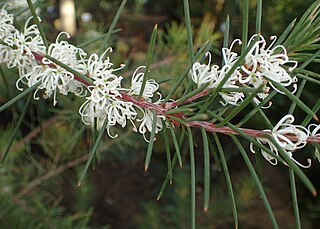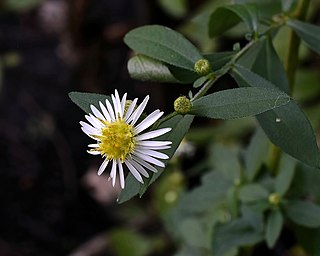
Epacris impressa, also known as common heath, is a plant of the heath family, Ericaceae, that is native to southeast Australia. French botanist Jacques Labillardière collected the species in 1793 and described it in 1805. Four forms have been identified, but no subspecies are recognised. Growing in heathland, shrubland or open forest, it is generally a small shrub around 0.5 to 1 m tall, with small stiff leaves. The red, pink or white tube-like flowers appear from late autumn to early spring. Honeyeater birds, particularly the eastern spinebill, feed upon the nectar of the flowers. It regenerates after bushfire by seed or by resprouting.

Banksia baxteri, commonly known as Baxter's banksia or bird's nest banksia, is a species of shrub that is endemic to Western Australia. It has greyish brown bark, hairy stems, deeply serrated leaves with triangular lobes and lemon-yellow flowers in an oval flower spike that grows on the end of branches.

Chrysocephalum, known by the common name everlastings for their long life as cut flowers, is a genus of flowering plants in the family Asteraceae. There are nine species, all of which were formerly classified under other genera.

Eucalyptus baxteri, commonly known as brown stringybark, is a medium-sized tree that is endemic the south-east of Australia. It has rough, stringy bark to the thinnest branches, lance-shaped or curved adult leaves, green to yellow flower buds in groups of between nine and fifteen, and cup-shaped or hemispherical fruit.

The National Herbarium of Victoria is one of Australia's earliest herbaria and the oldest scientific institution in Victoria. Its 1.5 million specimens of preserved plants, fungi and algae—collectively known as the State Botanical Collection of Victoria—comprise the largest herbarium collection in Australia and Oceania.

Hakea sericea, commonly known as bushy needlewood or silky hakea, is a large shrub with a profusion of mainly white flowers from July for several months. It is endemic to eastern Australia. It has become an environmental weed in some countries.

Kunzea baxteri, commonly known as scarlet kunzea, is a flowering plant in the myrtle family Myrtaceae, and is endemic to the south-west of Western Australia where it occurs near granite outcrops and hills. It is a shrub with large, scarlet, bottlebrush-like flower clusters, making it popular as a garden feature.

Chrysocephalum semipapposum, commonly known as clustered everlasting is a perennial shrub native to Australia. Clustered everlasting belongs to the family Asteraceae. C. semipapposum produces terminal flowers heads in clusters, mainly between spring and early summer with silver-grey appearing stems and branches. It grows up to 40cm high and 60 cm high, although there have been some varieties which can grow up to 1 m. C. semipapposum is often confused with Chrysocephalum apiculatum or 'yellow buttons', due to their similar appearances. C. semipapposum has 4 different subspecies, however they lack distinctive qualities and are often hard to identify. C. semipapposum is endemic to Australia and can be found in multiple states, most notably within Victoria. The plant is found in a variety of habitats including dry rocky regions. Clustered everlasting often grows sparsely and is rarely found in abundance and can be mistaken for a weed. Clustered everlasting has many uses, including as a source of nectar for butterflies, cut flowers or as an addition to a garden.

Olearia phlogopappa commonly known as the dusty daisy-bush or alpine daisy-bush is a species of flowering plant in the family Asteraceae that is commonly found in eastern New South Wales, Victoria and Tasmania. It is a small shrub with greyish-green foliage, daisy-like flowers in white, pink or mauve that can be seen from spring to late summer.

Ozothamnus obcordatus, the grey everlasting, is a shrub in the family Asteraceae, native to the states of Queensland, New South Wales, Victoria and Tasmania in Australia.

Goodenia hederacea, commonly known as forest goodenia or ivy goodenia, is a species of flowering plant that is endemic to eastern Australia. It is a prostrate to ascending, perennial herb with linear to elliptic or round leaves, and racemes of yellow flowers.

Acacia prominens is a shrub or tree in the genus Acacia native to New South Wales, Australia.

Hovea montana, commonly known as alpine hovea, mountain hovea or alpine rusty-pods, is a flowering plant in the family Fabaceae, and is endemic to Australia. It is a small shrub with narrow leaves and purple pea flowers.

Lomatia myricoides, commonly known as the river lomatia, is a shrub native to New South Wales and Victoria in southeastern Australia.

Prostanthera serpyllifolia, commonly known as small-leaved mint-bush, is a species of flowering plant in the family Lamiaceae and is endemic to southern Australia. It is a small shrub with small egg-shaped leaves and bright pink to red or metallic bluish-green flowers.

Lawrencia squamata is a species of plant in the mallow family, Malvaceae. It is endemic to Australia and occurs in all Australian states.

Cyanothamnus nanus, commonly known as the dwarf boronia or small boronia is a plant in the citrus family Rutaceae and is endemic to eastern Australia. It is a prostrate or low spreading shrub with simple or three-part leaves and white or pale pink four-petalled flowers.

Symphyotrichum ontarionis is a species of flowering plant in the family Asteraceae native to eastern North America. Commonly known as Ontario aster and bottomland aster, it is a perennial, herbaceous plant that may reach heights of 120 centimeters. Each flower head has many tiny florets put together into what appear as one.

Chrysocephalum pterochaetum, known by the common name perennial sunray is a perennial herb native to outback and desert areas of Australia. A member of the Asteraceae, the daisy family. A small plant, 15 to 40 cm high with many stems. Leaves are linear to linear oblanceolate in shape, 10 to 30 mm long, 1 to 1.5 mm wide. Leaf surfaces are rough and glandular, and may have felty white hairs. Yellow flowers mostly form throughout the year, but often seen from June to October. Originally collected in 1851 near Kanyaka, South Australia. The habitat of this plant includes sand among rocks, in or near dry creek beds, exposed rocky hill slopes and sandy gibber. The specific epithet pterochaetum is derived from the Ancient Greek language, ptero (winged) and chaetum (hair).

Craspedia aurantia, is a flowering plant in the family Asteraceae and grows in New South Wales and Victoria. It has light green leaves and heads of yellow to reddish-brown flowers on a single flowering stem.




















